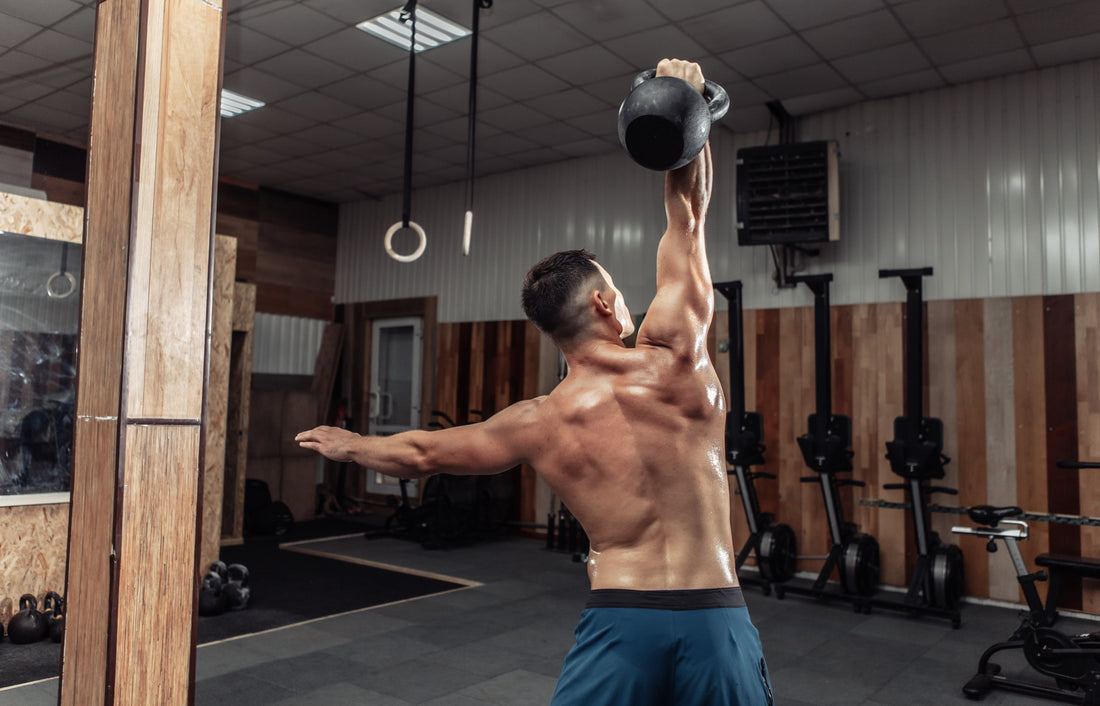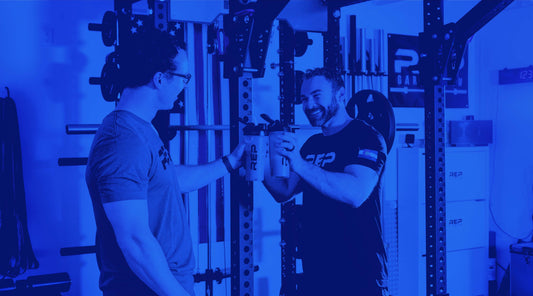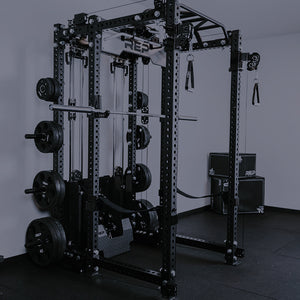
A trainer's favorite total-body kettlebell exercises.
I’ve been a personal trainer for ten years, and in that time, I’ve never met a “dumbbell fanatic.” Kettlebells, on the other hand? Folks swear by them—and for good reason. Kettlebells, or KBs, are among the most versatile and challenging pieces of equipment you’ll find in the gym.
In fact, one 2024 study considered kettlebell training “fundamentally functional,” noting that it “[enhances] strength, endurance, explosive power, and postural coordination,” particularly for athletes.
Here’s the best part: All you need is the right full-body kettlebell workout to reap the benefits. That’s where we come in.
A Certified Trainer’s 30-Minute Full Body Kettlebell Workout
The right full-body kettlebell workout kills three birds with one stone; you’ll break a sweat and get your blood pumping, fine-tune your athleticism and coordination, and build plenty of strength and muscle as well.
The Workout
- Turkish Get-Up: 2x5 per side
- Suitcase Deadlift: 3x6
- Half-Kneeling Single-Arm Shoulder Press: 3x8
- Goblet Squat: 2x12
- Bent-Over Row: 2x12
- Farmer’s Carry: 3 rounds of 20 paces
- Kettlebell Swing: 50 reps in as few sets as possible
What you’ll need: For this workout, you should have light, medium, and heavy kettlebells, plus 50-60 feet of open space to walk, such as turf or track.
This workout should take about 30 minutes. Keep your rest times to 1-1.5 minutes.
Kettlebell Exercise Form Guide
You’ve got the “what.” Now, let’s break down the “how” and “why” of the seven movements that make up this full-body kettlebell workout.
1. Turkish Get-Up
It may look a little silly, but the Turkish get-up is a fantastic kettlebell exercise. It involves multiple muscle groups in your lower and upper body, primes your flexibility and coordination, and helps you work up a sweat—the perfect way to start your workout.
How to do it:
- Lie on your back while holding a light kettlebell in the air with your right arm. Bend your right knee and plant that foot on the ground. Extend your left arm and leg out to the side on the floor.
- With your right arm extended, push the kettlebell up toward the ceiling by pressing into the floor with your right foot and propping yourself up on your left elbow.
- Shift to a more upright position by pushing off the floor with your left arm, using it as a kickstand to prop yourself up. Keep reaching the kettlebell toward the ceiling.
- Pick your hips up and draw your left leg back, placing that knee directly under your center of mass.
- Push off the ground with your left arm and come to a half-kneeling position with the kettlebell held above your head.
- Push off the ground with your front leg and stand up. Then, reset and do it all again with the opposite limbs.
One big thing: The Turkish get-up is a complex exercise with a lot of moving parts. That makes it a great way to start your full-body KB workout, but don’t be afraid to scale it down if you feel you don’t have good form yet. If you’ve never done get-ups before, practice without holding any weight, or stop at steps 2 or 3 (also known as the quarter and half get-up, respectively).
2. Suitcase Deadlift
We love the suitcase deadlift for its performance-oriented practicality. Hip hinge movements develop back and core strength while building your posterior chain; that’s your hamstrings, glutes, and lower back.
Most things we pick up off the ground day-to-day aren’t as secure and symmetrical as a barbell. Deadlifting with a kettlebell more closely matches the real-world tasks you need strength and stability to perform.
How to do it:
- Stand adjacent to a medium-to-heavy kettlebell with your feet under your hips.
- Reach down to the handle by pushing your butt backward and allowing your knees to bend slightly.
- Grasp the handle, ensure your back is flat and rigid, and brace your core.
- Hold your non-working arm out to the side for balance, or place it on your opposite hip.
- Push downward into the floor with your legs to stand up with the kettlebell.
- The important part: As you perform the suitcase deadlift, resist the kettlebell pulling your torso to one side. Keep your shoulders square and level. Let your arm relax and hang.
3. Half-Kneeling Single-Arm Shoulder Press
It’s a mouthful, but the half-kneeling single-arm shoulder press is extremely nutritious. Kneeling instead of standing demands more of your core, and pressing unilaterally—that’s one limb at a time instead of together—does wonders for your shoulder health and stability. The best part? It’s effective without requiring heavy weights.
How to do it:
- Take a knee while holding a light to medium kettlebell in your opposite-side hand at shoulder level (your down knee should be on the same side as your pressing arm).
- Hold your other arm out to the side for stability, or place that hand on your hip while bracing your core.
- Press the kettlebell up overhead until your arm is straight.
- Technique tip: For unilateral exercises, you can improve your balance by keeping your gaze glued to a specific point. Look at something in front of you and slightly toward the floor.
4. Goblet Squat
Think of the goblet squat as the quad-focused cousin of the suitcase deadlift. Squats of all stripes build your legs and butt, but holding the kettlebell in front of your body adds some real-world relevance while doubling down on core strength as well.
How to do it:
- Stand with your feet a comfortable distance apart, between hip and shoulder width, with your toes turned out at an angle that feels natural.
- Hold a medium to heavy kettlebell at chest level, clasped in your palms like a bowl (do not rest it against your chest).
- Take a breath, brace your core, and drop your hips down slowly.
- Squat down as low as you’re able while holding the kettlebell, then stand back up.
Personalize your form: The anterior, or in-front-of-your-midline, position of the kettlebell acts as a counterweight, which should help you maintain an upright torso. If you’re finding it difficult to maintain good form because your torso is tilting forward too much, try holding the weight further from your body, or elevate your heels slightly.
5. Bent-Over Row
Your posterior chain doesn’t stop at your lower back. To train your lats, rhomboids, traps, and rear delts, you need to perform an upper-body pulling exercise like the kettlebell bent-over row that hits all those muscles at once.
How to do it:
- Stand with your feet hip-width apart while holding two light to medium kettlebells.
- Hinge at the hips, pushing your butt backward like you’re taking a bow until your torso is at roughly a 30-degree angle with the floor.
- With your arms hanging down, brace your core and take a breath in.
- Row the kettlebells by pulling your elbows up and out to the sides.
- Change it up: If you want to focus on building muscle and strength in your back, row two kettlebells simultaneously. To emphasize core stability and unilateral shoulder strength, row one side at a time while holding the other arm out to the side for balance.
6. Farmer’s Carry

After we’ve hit two upper body and lower body exercises, it’s time to wrap things up with some functional conditioning. I’ll endorse the farmer’s carry any day; carrying something heavy safely is a fundamental life skill, and kettlebells are the perfect tool for the job.
How to do it:
- Stand with your feet under your hips and hold a medium to heavy kettlebell by your side.
- Brace your core and walk forward, keeping your shoulders level and your arm loose.
Make it count: Take slow and deliberate steps—you’re not rushing to make your connecting flight at the airport here. As you walk, fight hard to keep your torso still while feeling your weight transfer from one leg to the other on each step.
7. Kettlebell Swing
The swing is the quintessential kettlebell exercise. It’s an explosive lower-body move (that you can only perform with a KB) which builds athletic power, helps you break a sweat, and torches your posterior chain. No full-body kettlebell workout is complete without some swings.
How to do it:
- Take a wide stance around shoulder-width apart while holding the handle of a medium to heavy kettlebell between your legs.
- Slowly start rocking your hips back and forth to generate momentum while keeping your arms loose and relaxed.
- As you gain momentum, allow the bell to swing back between your legs while you swiftly tip over into a hip hinge.
- Thrust your hips forward and let the kettlebell swing out and up in front of your body as you come to a standing position.
- As the kettlebell falls and starts swinging back between your legs, fall into another hip hinge, and repeat.
The essentials: Kettlebell swings are rapid, ballistic movements. As you figure out the technique, let the bell move freely like a pendulum. Keep your arms relaxed and you’ll find the rhythm of “snapping” your hips into extension and then transitioning into the hinge.
How to Choose the Right Kettlebell Type, Size, and Weight
You know kettlebells by their distinct globular shape and ergonomic, easy-to-grab handle. These design elements are what separate KBs from other types of free weights, like barbells or dumbbells, where most of the item’s weight is dispersed on either side of your hand.
Putting the bulk of the weight in front of your hand lets the kettlebell’s handle spin freely in your palm, opening up even more workout customization. But the options don’t end there:
Types of Kettlebells
- Cast Iron: Most kettlebells are made from single slabs of cast iron, and are durable enough to take a beating in the gym whether you’re doing basic movements or power-building exercises.
- Competition: Kettlebell lifting is its own sport as well. Competition kettlebells are uniform in size, whereas the run-of-the-mill kettlebells you’ll find in most gyms get bigger as they get heavier.
- Adjustable: Like adjustable dumbbells, you can find adjustable kettlebells as well that save space (home gym crew, that’s you!). However, they’re not always as ergonomic or aerodynamic as uniform weights.
Choosing Size and Weight
Like any form of strength training, full-body kettlebell workouts are most effective when you use a load that’s appropriate for the exercise in question.
For example, trying to “max out” your Turkish get-up, a move tailored toward balance and posture, is unwise and potentially dangerous. So, what do we mean when we call kettlebells light, medium, or heavy?
There are no universal guidelines here, since we all have different levels of strength. Moreover, kettlebells come in both pounds and kilograms. Generally speaking, though…
Light kettlebells typically range from 2 to 25 pounds (11 kg). Go for kettlebells in this range when performing isolation exercises or trying a new movement you aren’t familiar with.
Medium kettlebells, broadly, could range from 30 to 60 pounds (27 kg). You’ll often work with two at a time, especially for certain lower-body exercises.
Heavy kettlebells are, well, heavy. Most gyms carry a few kettlebells above the 60-pound mark, and you’ll occasionally see some 100-pound-plus (45 kg) bells. In general, save the heavy weights for “big” lifts like squats, deadlifts, cleans, and carries.
The Big Picture
At the end of the day, the best workout is the one you can stick to. That’s why I’ll go to bat for kettlebells any day; kettlebell training is hard to beat for anyone who prioritizes practicality and efficiency in their fitness routine.
With the right kettlebell workout, you can build strength, elevate your athleticism, improve mobility, and prepare yourself for anything life throws your way. The best part? You don’t need a gym full of equipment to get it done. All you need are a few kettlebells and a plan that works.
You’ve got the plan—now get to work. And if you need kettlebells, you’re already in the right place.
FAQs
What are the benefits of kettlebells?
Kettlebells are uniquely designed to add an athletic element to strength training. They’re extremely versatile and are effective for gymgoers of all skill levels. These qualities also make kettlebells one of the best tools for time-efficient full-body workouts.
When to use kettlebells vs dumbbells?
Kettlebells are made to be swung, carried, pulled, pressed, and basically everything else. However, they are not as stable as dumbbells and many gyms don’t carry a wide array of weights.
If you’re looking to break a sweat, perform a circuit workout, or improve explosive power, kettlebells are your best friend. To prioritize pure muscle growth and strength gain, dumbbells are often the better pick.
Can you do full-body kettlebell workouts every day?
Yes! Kettlebell workouts make for a great everyday fitness routine. That said, if you work with KBs daily, your sessions should be short and sweet.
Pick one upper body move, one lower body exercise, and something athletic like a carry, swing, or Olympic lift variation. Run through a few rounds of each and you’re good to go.

NEWSLETTER SIGNUP
Product launch information, promotions, blogs, and REP news.







